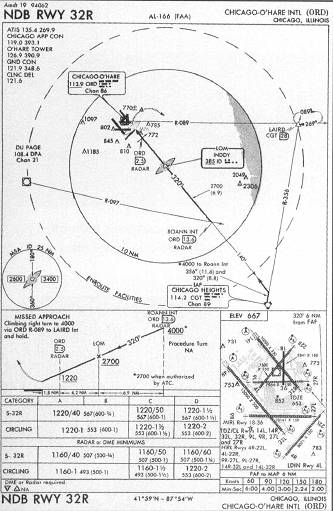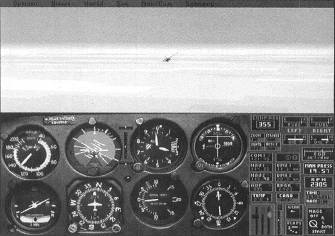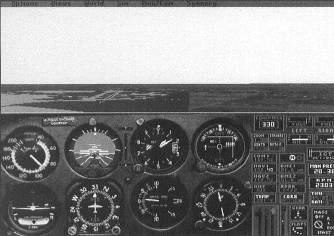Microsoft Flight Simulator Handbook
by Jonathan M. Stern
Non-Terminal NDB Approach
I have selected the NDB Rwy 32R IAP as the approach to make to O'Hare International Airport. Figure 18.36 is the chart for that approach.

Start by recalling the Heights situation and pausing the simulation. Change the NAV 2 display to the ADF. You should be over the top of the Chicago Heights VORTAC at 3,000 feet MSL. Before you unpause, study the approach chart so that you know what you need to do after you unpause.
In the plan view, you can see that the ATIS frequency for O'Hare is 135.4. Monitor the ATIS for the current information and then tell ATC that you have "Information ___."
Chicago Heights VORTAC is the initial approach fix (IAF) for this approach. Fly the depicted approach segments from the Chicago Heights VORTAC to the INDDY NDB. The fan marker symbol at INDDY, as well as the LOM in the profile section, indicates that the NDB is collocated with an outer marker.
Because the NDB is located six miles from the runway threshold, this approach is of the non-terminal variety. In other words, the missed approach point is not at the location of the navigation facility on which the approach is based.
The initial approach segment calls for flight at or above 4,000 feet from Chicago Heights for 11.6 miles along the 356° radial, followed by 8.8 miles of flight inbound on the 320° bearing to INDDY. That gets the airplane to ROANN intersection. At ROANN, the airplane may be descended to 2,700 feet while continuing to track inbound on the 320° bearing to INDDY.
ROANN intersection is a step-down fix that can be identified in three ways. Any of the ways require use of the ADF to identify the 320° bearing to INDDY. The specific location along the bearing, however, can be identified by the intersection of the Du Page 097° radial, radar identification by ATC, or 13.6 DME from the Chicago-O'Hare VORTAC.
The approach is somewhat unusual in that the DME distance information comes from a facility other than that being used for course guidance along the approach. That should bring the aircraft to the INDDY NDB. The approach continues past INDDY, following the 320° bearing from INDDY until the missed approach point, which is based on elapsed time from passing INDDY.
With respect to altitudes, the profile view reflects a minimum altitude of 4,000 feet until inside ROANN. An asterisked note states that the approach segment can be flown as low as 2,700 feet with ATC authorization. Assume that such authorization has been provided on your flight. After passing ROANN, the airplane may be operated at altitudes as low as 2,700 feet. Inside the INDDY LOM, the airplane may be descended to 1,220 feet. Finally, there is a step-down fix at 2.5 DME from ORD (the Chicago O'Hare VORTAC) that allows descent to the MDA. If the airplane is not equipped with DME and ATC radar is inoperative, 1,220 feet becomes the MDA.
The landing minima section reflects an MDA of 1,160 feet, which is 507 feet above TDZE. This is reflected by the 507 after the MDA. Interestingly, on this approach, the HAA, or height above airport, associated with circling minima, is less than the HAT. This is because the airport elevation is 14 feet higher than the TDZE, and the circling minima, at least for category A, B, and C aircraft, are the same as the straight-in approach minima.
If the approach is completed in IMC, the missed approach procedure should be studied. The highest obstacle depicted on the chart is the Sears Tower, which is shown to be 2,306 feet MSL.
If you're comfortable with the approach procedures, give the approach a try:
- Unpause and track outbound along the 356° radial from Chicago Heights at 3,000 feet for 11.6 miles. The NAV 1 should be tuned to Chicago Heights, whereas the ADF should be active in place of the NAV 2 display. Tune the ADF to 385.
- Even with the ADF displayed, the NAV 2 can be used for DME information on Flight Simulator. Accordingly, tune NAV 2 to Chicago O'Hare on frequency 113.9. Equipped with DME, there should be two indications that you are approaching the point at which you switch from VOR to NDB navigation.
First is the approach of 11.6 DME on DME 1, the DME distance increasing as you fly away from Chicago Heights. Second is the relative bearing displayed on the ADF. Because the desired bearing to the NDB is 36° left of the radial you are tracking, an indication that you are on the bearing is when the ADF needle is 36° left of the nose, or a relative bearing of 324°.
Unfortunately, the INDDY LOM on Flight Simulator was programmed with insufficient transmission range. Although a compass locator must have a usable range of 15 nautical miles, INDDY is not received until the aircraft is 13.7 miles away. Because the accuracy of navigation with the ADF depends on the accuracy of the heading indicator, the VOR/DME indication may, in any case, be somewhat more accurate. When you reach 11.6 DME from Chicago Heights, turn left and fly a 320° heading. (See Figure 18.37.)
Figure 18.37 Because the NDB is not in range, 11.6 on the DME 1 is your signal to start the left turn to a heading of 320 degrees.
- Meanwhile, slow the airplane to approach speed.
- You no longer need Chicago Heights for navigation. Switch the NAV 1 receiver to the Du Page VOR. Use the Du Page crossing radial to identify ROANN.
- After you pass ROANN, descend to 2,700 feet. Use normal NDB tracking procedures.
- Complete the Before Landing checklist at this time. After passing the INDDY LOM, indicated by reversal of the ADF needle and the outer marker signal, lower the landing gear and descend to 1,220 feet. (See Figure 18.38.)
- Note the time for purposes of timing the approach to the missed approach point. Use NDB outbound tracking procedures to remain on the final approach course. Finally, at 2.5 DME from ORD, you can descend to the MDA.
- If the runway is in sight and you're in a position from which a normal landing can be made, go ahead and land. If not, execute the missed approach procedure at the appropriate time. (See Figure 18.39.)
Figure 18.39. At the missed approach point, you have the runway in sight and you are in a position from which the approach and landing can be complete using normal maneuvers.

Table of Contents
Previous Section: Flying The NDB Approach
Next Section: Terminal NDB Approach
